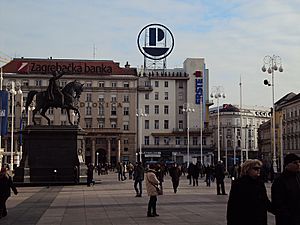Ignjat Fischer facts for kids
Quick facts for kids
Ignjat Fischer
|
|
|---|---|
| Born | 18 June 1870 |
| Died | 19 January 1948 (aged 77) |
| Nationality | Croat |
| Occupation | Architect |
| Buildings | Parliament of Croatia |
Ignjat Nathan Fischer (born June 18, 1870, in Zagreb – died January 19, 1948, in Zagreb) was a famous Croatian architect. He worked in Zagreb for many years during the early 1900s. He designed many important buildings that you can still see today.
Contents
Early Life and Education
Ignjat Fischer was born in Zagreb, which is now the capital of Croatia. His family was Croatian Jewish. His father, Samuel, was a well-known engineer who built things.
Ignjat studied architecture in two important European cities. He went to school in Vienna, Austria, and then in Prague, which is now in the Czech Republic. These studies helped him become a great architect.
Designing Buildings: Ignjat Fischer's Career
In his early career, Ignjat Fischer helped bring a new style of architecture to Croatia. This style was called the Vienna Secession. It was known for its unique shapes and decorations.
Early Designs and the Vienna Secession Style
Fischer created several impressive buildings in this style. For example, he designed the Rado house in 1897. He also designed a special hospital building in 1908. This building was known for its V-shaped layout. In 1912, he designed parts of the Medical Faculty at Šalata.
Later Works and Modern Styles
After World War I, Fischer's style changed. He started designing buildings that looked more modern. He also used elements from older styles, but in a simpler way.
Some of his most important works from this time include:
- The Forestry Academy building in 1920.
- The City Savings Bank palace in Ban Jelačić Square. He designed this large building between 1922 and 1925. It was even made bigger in 1931.
- The modern Arko house near the Dolac Market.
We are still learning about all the buildings Fischer designed. Recent studies have found that he designed even more buildings than we thought. One of his most notable designs is the building of the Croatian Parliament. This important building is located in St. Mark's Square. Fischer had a big office in Zagreb. He designed as many as forty different buildings there!
Personal Life and Challenges
Ignjat Fischer was a member of a group called Croatian Freemasonry. He was married to Helena, whose maiden name was Egersrodfer. They had two daughters together, named Ivana and Marija Magdalena.
Life became very difficult for Fischer during World War II. His health suffered because of the events happening around him. His daughter Ivana shared a sad memory. She said her father was put in prison when he was 70 years old. This happened because he was Jewish. These difficult experiences made him very sick. Ignjat Fischer passed away in 1948. He was buried at the Mirogoj Cemetery in Zagreb.


